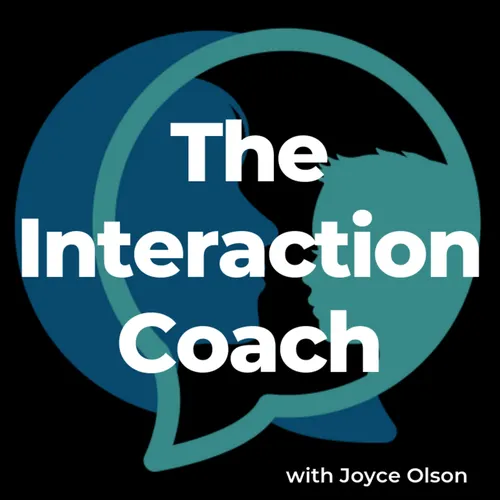
The Interaction Coach
You can help your child learn to talk with speech-language pathologist Joyce Olson of The Interaction Coach. Listen to daily tips that make every interaction a learning opportunity for speech and language development. Whether your child needs to start using words, make longer sentences, or improve social communication, this podcast is for you.
- Update frequency
- every day
- Average duration
- 6 minutes
- Episodes
- 234
- Years Active
- 2019 - 2020

5.174 TURN TAKING: Expand turn taking with objects to new places and activities
Turn taking supports your child’s developing imitation skills. You can model the action with new materials, or use similar materials or actions in a new location. Adding something new keeps things in…

5.173 SOCIAL INTERACTION: Turn taking: Model how to share a toy
Get early intervention information mentioned in the episode here.
Here’s the link to the short screener for finding your child’s level of communication development.
Turn taking lays the foundation fo…

5.172 SOCIAL INTERACTION: Joint Attention: Enjoy bubbles together
Bubbles are great attention-getters! There are many ways to call attention to a bubble. Be sure to remember that joint attention includes checking the other person’s face sometimes.
Today’s activity:…

5.171 SOCIAL INTERACTION: Joint Attention: Shift to your child’s focus of attention
Send your questions to [email protected].
Remember that parents don’t cause their child’s communication delay. They are, however, in the best position to provide frequent, enriched interactio…

5.170 SOCIAL INTERACTION: Joint Attention: Model joint attention with things that are worthy of attention
Send your questions to [email protected].
Joint attention means both of you are sharing your attention toward some other interesting thing. You know you're sharing attention when you each are…

5.169 SOCIAL INTERACTION: Mutual Attention: Play peek-a-boo with mobility
Download the list of targets and activities for Level 5 here.
When your child learns a play routine, you can build on their knowledge by using the game in new ways. Expand on playing peek-a-boo by d…

5.168 SOCIAL INTERACTION: Mutual Attention: Do action songs together
Download the list of targets and activities for Level 5 here.
Mutual attention is important for your child’s learning. There’s lots of important information on your face—how you make speech sounds,…

5.167 SOCIAL INTERACTION: Mutual Attention: Expand on social games
Download the list of targets and activities for Level 5 here.
You started doing social games at earlier levels. Now your child can use them to initiate interactions with you. They can transfer the …

5.166 SOCIAL INTERACTION: Mutual Attention: Position yourself face-to-face
Download the list of targets and activities for Level 5 here.
Mutual attention means both of you are paying attention to each other. It includes noticing what the person is doing and noticing the pe…

4.165 LITERACY: Writing: Take turns with crayon
Any activity you do together with your child gives you opportunities to practice turn taking.
Today’s activity: Share a crayon while scribbling. You make a mark, then pass the crayon to your child. A…

4.164 LITERACY: Writing: Scribble on paper
Your child can control their hand movements and fingers more precisely. They can scribble on paper and hold an item between their thumb and forefinger.
Establish habits for how to use writing materia…

4.163 LITERACY: Reading: Read face-to-face
You can change up your location when sharing books with your child. Reading face-to-face lets your child see how you form the sounds and words, and lets them see your facial expressions. This gives y…

4.162 LITERACY: Reading: Let child be the reader
Your child is more familiar with books and can turn the pages independently. They want to do more on their own, so decide which books they can have on their own.
Continue to guide your child’s use of…

4.161 LITERACY: Reading: Use single pictures and a word
At Level 4 your child will turn the pages of a book and touch pictures consistently. They become more independent in using books, and have favorite items in books.
Today’s activity: Use books with on…

4.160 LANGUAGE: Using Speech: Respond to imitation with a word
When your child imitates your word, they won’t say it with precise articulation. It will sound like “baby talk.” If they use the same sounds consistently and you know what they mean, that counts as a…

4.159 LANGUAGE: Using Speech: Respond to child’s meaning
Your child needs to learn that communication is the sharing of meaning. If we focus too much on how your child is making their speech sounds at this level, it can interfere with their purposes for co…

4.158 LANGUAGE: Using Speech: Imitate intonation talking on phone
Read about recommendations from the American Academy of Pediatrics on screen time for children.
A toy phone gives your child the chance to babble like they’re having a conversation.
Today’s activity:…

4.157 LANGUAGE: Using Speech: Use exclamation “uh-oh”
An exclamation expresses a meaning; it counts as a word. It can be used flexibly in many situations. Your child will learn when to use it and what it can mean from your uses of the exclamation.
Today…

4.156 LANGUAGE: Using Speech: Turn taking with varied babbling
Your child will pay lots of attention to your face and voice as you talk face-to-face. You can see them moving their mouth as if they are trying to do it like you.
Skills that develop include: babble…

4.155 LANGUAGE: Making Meaning: Use gesture “wave”
Get the checklist: 16 gestures that help your child learn to talk.
Waving is a gesture your child learns through imitation. Gestures are an important foundation for intentional communication.
Today’s…